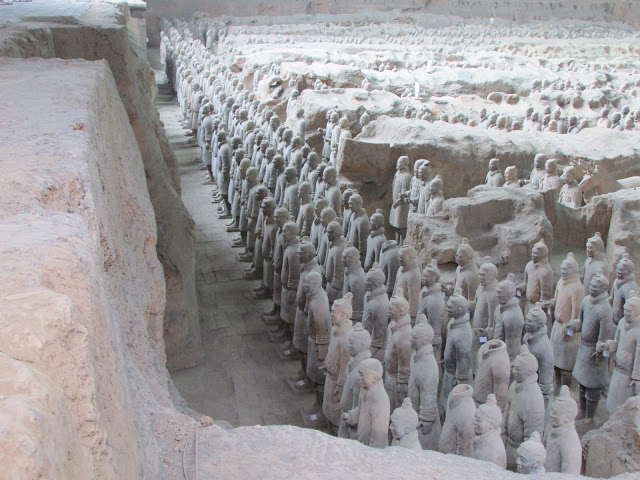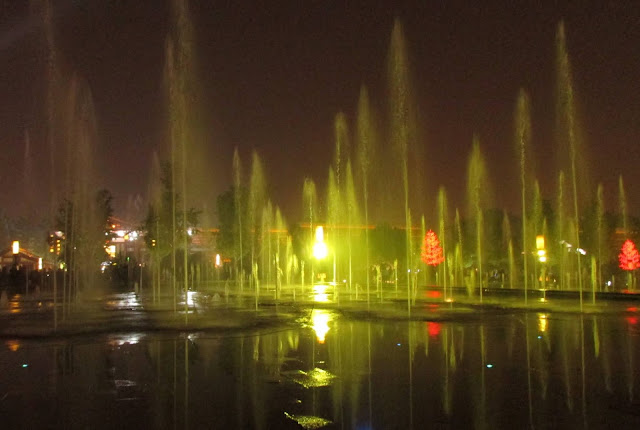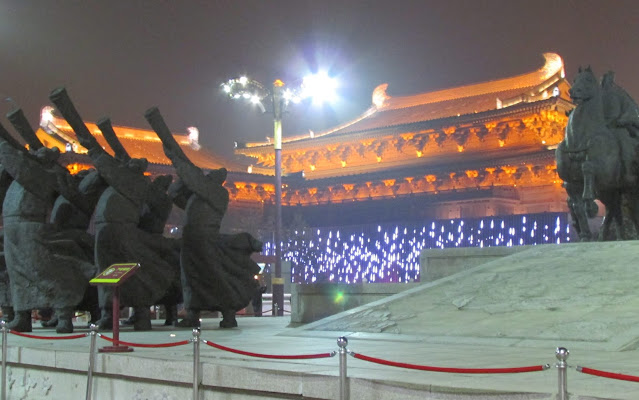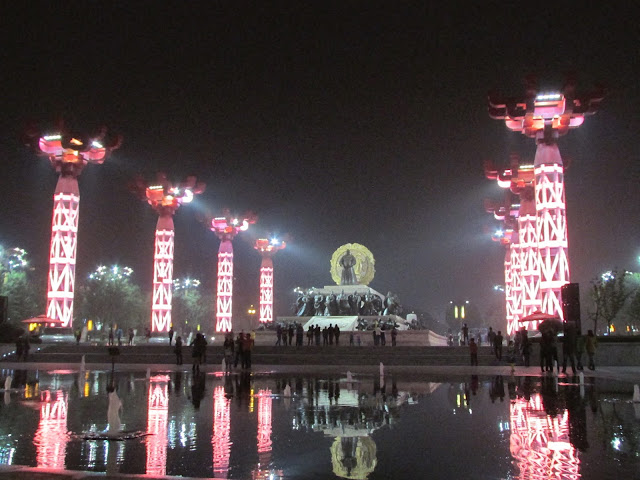Xian
We arrived in Xian (pronounced Chi An), part of 'Middle China'; a very mountainous country - once home to most of China’s panda population. We didn't pick up a new local guide here (as was usual) as this was our tour guide Bruce’s hometown and didn’t he just love his home city! He was so enthusiastic about its history, culture, and architecture! We were told stories of long-ago emperors, their concubines (one had 3000 concubines at once!), and much, much more. There are over 10 million people living in this ancient capital, which was once home to the Qui, Han and Tang dynasties - dating back over 2000 years. But it was in the 3rd century, (in the Han dynasty), that trading on the infamous Silk Road began - which saw China begin to prosper. The first Silk Road started in Xian and went overland as far as Rome, the second was taken north, over the grasslands in the time of Genghis Khan; and the third went to the port of Shanghai and beyond.

As it was too late to go to our hotel to change, we went straight to the theatre, where we were also having a meal before the show. It seemed that each city in China has its own specialty when it comes to food, and Xian was no exception. Here we were treated to dumplings - 16 different varieties. We had everything from seafood ones, duck ones, pork, chicken, various vegetables, and even walnut flavoured ones. Many of them were made to look like what was inside them, such as a pig’s face, a duck, or walnut etc. The show was completely different to any of the other shows we had seen on our trip. It was an Imperial Classical musical from the Tang Dynasty period; with music and dance that was written over 1300 years ago, including the famous 'feather dance', and a beautiful lady playing the lyre. The costumes and dancing were beautiful, very serene and graceful - it was delightful to watch. We didn’t get to our hotel until 10.30pm, it was a very late check-in!

The next morning, after fighting to get down the lift from the seventeenth floor; (it felt like half of Xian was trying to get their suitcases downstairs to breakfast) - we were off again. The first stop was a factory that makes lacquerware, rugs and terracotta warriors (we were shown how they were made using existing moulds) and it sold many tempting items. The lacquerware was so beautiful – I wish I could have been able to fit some of it in my suitcase!
Next, we carried on to the Museum of the Terracotta Warriors - a collection of terracotta sculptures depicting the Army of Qin Shi Huang, the first Emperor of China. Work on his mausoleum began in 246 BCE, soon after he ascended the throne - although he was only 13 at that time; and these items were buried with him. I didn’t know much about the Terracotta Army before I went and found it absolutely fascinating.


The Terracotta Army was discovered on 29 March 1974 by a group of farmers who were digging a well approximately 1.5 kilometres east of the Emperor's tomb mound at Mount Li. Up to 5 metres of reddish, sandy soil had accumulated over this site in the 2000 years following its construction. This discovery prompted Chinese archaeologists, to investigate - revealing one of the most incredible archaeological discoveries in China's history.

In the distance, as it was really misty, we could just make out a type of hill - the tomb mound of Emperor Qin Shi Huang - which has never been opened! The Chinese know that if anyone opens this, they would probably be killed by booby traps of arrows, trap doors, hidden pits, spikes etc. Also, within a few minutes of oxygen coming into contact with the bodies and other contents (that have been preserved for thousands of years), they would shrivel up and crumble into dust. After the excavation of the Terracotta Army, the lacquer covering the painted surfaces of the figures curled and the paint flaked off within minutes after removing the mud surrounding them. The Emperor’s army of Terracotta soldiers, together with the horses and his treasures were situated quite close to this unopened mausoleum, supposedly to look after him in his next life.

Buried in the 3 pits near Qin Shi Huang’s mausoleum, it is estimated that they contain more than 8,000 soldiers, 130 chariots with 520 horses, plus another 150 cavalry horses. The area is now a museum complex, with the largest pit being enclosed by a roofed structure. The unopened tomb mound is surrounded by walls built of earth, with gateways; and includes structures such as offices, halls, and stables surrounded by a park.
Four main pits approximately 7 metres deep have so far been excavated – although work is continuing all the time. The soldiers within, were laid out as if to protect the tomb; and although they all look the same from a distance, they vary in many ways once you get close. Pit 1 contains the main army of more than 6,000 figures. It originally had paved corridors with a wooden ceiling supported by large beams and posts and would have resembled palace hallways. The wooden ceilings were covered with reed mats and layers of clay for waterproofing.
The terracotta figures are life-sized and vary in height, (officers typically taller) uniforms, and hairstyle according to rank. Their faces appear to be different, but only 10 basic face shapes have been identified. There are also figures of infantry; cavalrymen, armoured drivers of chariots; kneeling archers; as well as generals and other officers; with terracotta horses placed among the warriors.

Pit 2 has cavalrymen, horses and infantrymen, along with 90 wooden chariots - and is thought to represent the military guard. Pit 3 is the command post, with high-ranking officers and a war chariot. Other pits contain bronze carriages, terracotta figures of acrobats, strongmen, officials, stone armour suits, horses, rare animals and labourers, as well as bronze cranes and ducks.
Originally, the figures were painted and lacquered; and given individual facial features such as eyebrows and facial hair, that would have given them a realistic look. Heads, arms, legs, and torsos were created separately and then assembled.
Once completed, the terracotta figures were placed in the pits in
precise military formation according to rank and duty. Over 40,000 bronze items
of weaponry have also been recovered, including swords, daggers, spears,
lances, battle-axes, scimitars, shields, and crossbows.
At the rear of the pit, work continues every day in the section allocated for archaeological digs. The horses with the chariots are in a very dark room to preserve them further. Everywhere was very crowded and I had to be careful not to get pushed over the railings or down the stairs.
I found the pits a phenomenal sight, the uniformity was astounding! When the only photographs you see, are of rows and rows of the same-coloured soldiers, it was hard to imagine what an amazing sight it would have been in colour! What an experience it had been! Next, we drove an hour or so, through the countryside where the main crop is pomegranate and kiwi fruit (aka Chinese Gooseberry), to the Muslim quarter. This was just another chance to see local foods being prepared, especially foods on sticks as well as walnuts being cooked; and of course, the chance to shop again!
After our evening meal we were given a guided tour of Bruce's ‘home city at night’. The first stop was outside a huge shopping mall, whose ceiling had the biggest led screen I have ever seen; it was constantly changing from videos of fish swimming under water, to leaves blowing in the wind, snow falling, and many other images.
Then we went to see the musical fountains - that are supposed to be the largest in all of Asia - they were the best fountains I have ever seen. The music played for an hour, and in all that time, the water, covering a huge area, changed colour, shape, and size every few seconds.
Such a colourful spectacle, it was incredible, especially against the backdrop of the Large Wildgoose Pagoda.
We expected to go back to our hotel when it had finished, but we were in for another treat!
We went a walk through a series of parks known as Kaiyuan Plaza, containing fountains, bronze statues, replicas of Terracotta Warriors, illuminated trees and pillar-like structures that were all lit up.
These pillars had colourful illustrations on them that were constantly changing colour - and laser lights filled the sky. Words could not describe these lights - everywhere you looked, there was something different glowing - it was amazing!
The colours were so vivid and bright – it really was the most unexpected surprise.
An hour later, back on the coach; we passed more buildings that were lit up; the entire city wall, south gate pagoda, and the bell tower, which is said to be The Centre of Xian - and all of China. What a day and night it had been! To think I only thought we were going to see the Terracotta Warriors in Xian.
Next morning the first thing we did was to walk upon the City Walls of Xian, (an extension of the old Tang Dynasty structure), built as a result of the wall-building campaign ordered by the first emperor of Ming Dynasty in the 14th century.
It claims to be the most complete city wall to have survived all through China's long history; and is surrounded by deep moats. It is 12 metres high, 8.5 miles long and was supposedly made from earth, sticky rice, and egg whites (which made the wall extremely strong) although later, the wall was totally enclosed with bricks.
Next stop was the Little Wild Goose Pagoda – an awesome sight.
Work originally started on the pagoda in 581AD and during an earthquake in the 15th century, it split in two from top to bottom. No one went into the building for 34 years, until another huge earthquake joined it back together. When the building was inspected, it was found that the foundations were built like a half sphere, apparently a shape that can withstand a great amount of movement.
The gardens here were lovely and not too busy for a change. As we wandered through the park, we were told that every building has a raised threshold, (about 10 inches high), which we had to step over. The Chinese believe in ghosts, and that they float from house to house and room-to-room - so, as ghosts don't have feet, they just hover above these steps.
In this same complex, we were invited to take part in a Tai Chi lesson, which was fun; and then we went to see a Master Calligrapher at work.
He explained how Chinese letters were written and wrote my name on some rice paper for me to keep! There were some beautiful pieces in his shop!
After lunch we visited The Shaanxi Provincial History Museum, which attracts millions of visitors every year and today was no exception - it was so, so busy.
The Museum was built as a Tang Dynasty style complex and is divided into different exhibition areas. These halls display precious cultural relics of prehistoric times, as well as items from the dynasties of Zhou, Qin, Han, Three Kingdoms, Jin, Sui, Tang, Song, Yuan, Ming and Qing.
There is also delicate pottery, bronze, gold and silver wares, and exhibitions about Shaanxi local culture, the Terracotta Figures, and the history of the Silk Road.
That was the end to my fascinating whistle stop couple of days in Xian and time for a much-needed rest on the flight to Beijing.
Thank you for taking time to follow my adventures,
Lynne
These are my other blogs :-
























































